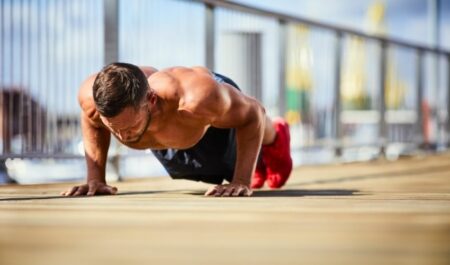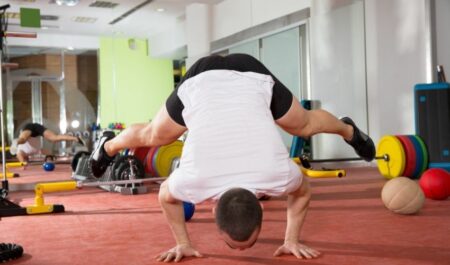It’s possible that you’ve heard about the One Punch Man workout if you’re a manga reader or a fitness enthusiast who keeps up with the current training fads. The workout takes its inspiration from the Japanese superhero franchise “One-Punch Man,” which was created by the pseudonymous manga artist known only as ONE. It has gained popularity among fans of the series, in part because to the efforts of internet influencers who have attempted to follow the practice for a period ranging from 30 days to several years.
It is explained in detail in this post where you can learn everything you need to know about the One Punch Man workout: its origins, structure, hazards, benefits, and effectiveness.

What Exactly is The One Punch Man Fitness Routine?
It has already been mentioned that the One Punch Man workout takes its inspiration from the manga and following anime series of the same name. The fictitious superhero Saitama, often known as the One-Punch Man, is the central character of the series.
Saitama is an extraordinarily powerful fighter that can easily defeat any opponent with a single blow. In fact, Saitama plays a crucial role in the continuing struggle between monsters and superheroes that the series is based on.
Saitama claims that following the One Punch Man regimen, which consists of 100 situps, 100 pushups, 100 squats, and a 6.2-mile (10-kilometer) run, helped him to gain muscle and increase his strength.
The workout takes three years to complete and results in Saitama losing all of his hair while simultaneously developing his knockout power with only one punch. This ultimately allows him to overcome the demons. As a result, the One Punch Man workout was formed.
An adaptation of the One Punch Man workout is based on the manga series of the same name. In the story, the main character gains the ability to defeat any opponent with a single punch after performing the routine on a regular basis for three years.
The Advantages And Disadvantages Of One Punch Man Workout.
Here’s a quick rundown of the workout’s advantages and disadvantages:
One Punch Man Workout Pros.
Exercises such as pushups, situps, and squats are excellent for developing strength and endurance. Running 6.2 miles (10 km) on a regular basis can help you maintain or enhance your heart health. In theory, the program is straightforward.
Cons of the One Punch Man Workout.
It’s very demanding for first-time players. Due to overuse, poor technique, and a lack of rest days, there is a chance of injuries occurring. It is unbalanced and unsuitable for achieving long-term fitness objectives.
How to Perform the One Punch Man Workout?
As outlined in the book, completing the One Punch Man routine in its entirety is very uncomplicated — at least in principle. Every day, simply complete 100 situps, pushups, and bodyweight squats, as well as a 6.2-mile (10-kilometer) run.
Listed below is a breakdown of the technique for each of the bodyweight movements:
Situps
In Situps, you will primarily work your abdominal muscles and hip flexors. Situps are a traditional bodyweight core exercise that you can do anywhere.
To accomplish situps, follow these steps:
- Lie down on your back with your knees bent and both feet flat on the floor to perform this exercise.
- Place your hands behind your head or cross your arms over your chest to show that you’re not afraid.
- You should avoid tugging on your head from behind and forcing your chin too hard on your chest when you are sleeping.
- Sit up as far as possible in a controlled manner till your chest is nearly touching your thighs once you have achieved the desired position.
- Return to the starting point in a gradual manner.
- Repeat until you reach the desired number of repetitions – in this case, 100 reps.
Pushups
Pushups are a simple bodyweight workout that works your chest, shoulders, and core muscles all at the same time.

Push-ups should be performed as follows:
- In a straight-arm plank posture with your back flat and hands on the floor just under your shoulders, start with one arm straight and one arm bent.
- Begin to slowly drop your torso and body toward the floor, bending your elbows along the way.
- Press through your hands to bring yourself back to the top position after you have reached approximately 1 inch (2.5 cm) above the floor.
- To keep your hips from drooping toward the floor throughout the move, keep your core fully engaged throughout.
- Repeat until you reach the desired number of repetitions — in this case, 100 for this workout.
Squats
A lower-body exercise that primarily targets your glutes and quads, with some activation in your calves and hamstrings, bodyweight squats are a great choice.
Bodyweight squats should be performed as follows:
- Standing with your feet around hip-width apart and your toes turned out between 5 and 12 degrees is a good starting point.
- To begin the lowering phase of the action, bring your hips backwards and forwards.
- As you naturally bend at the knees, lower your hips to the floor.
- Maintain your balance by keeping your weight in the middle of your feet.
- Maintain an erect posture with your back straight.
- Maintain a straight line from your knees to your toes by bending them in the same way.
- Continue to lower yourself as far as you can without your back rounding or your knees collapsing in on themselves.
- Aim to have your thighs at least parallel to the floor when performing this exercise.
- Make a strong push with your feet to return to the starting position.
- Repeat for the desired number of repetitions — in this case, 100 reps for this workout.
Putting Everything Together
The entire workout consists of 100 repetitions of each activity, executed with appropriate technique, followed by a 6.2-mile (10-kilometer) run to complete the circuit. In principle, you should be able to complete the workout without taking much time off.
However, in practice, you may find yourself needing to take a break after 100 reps or so, as well as between exercises. The whole One Punch Man workout consists of 100 situps, pushups, and squats, followed by a 6.2-mile (10-kilometer) run to burn off the excess calories. Ensure that all repetitions are carried out with good technique.
The One Punch Man Workout Has a Number Of Advantages.
Muscular strength and cardiovascular fitness increases are two of the many advantages of this exercise session.
The Advantages Of Bodyweight Movement
The following are some of the research-backed advantages of completing the bodyweight movements utilized in the One Punch Man exercise routine:
- Pushups have been shown to increase strength in the pectoral and upper trunk muscles.
- As your pushup technique improves, you will have a lower chance of cardiovascular disease.
- Squats have been shown to lower body fat percentage.
- Squats have been shown to increase leg muscle thickness.
- Squats have been shown to increase quadriceps strength.
Running Has Numerous Advantages.
Run a few laps around the track to complete the One Punch Man workout. Running regularly, according to a large body of data, enhances your fitness. The following are some of the general research-proven advantages of frequent running for physical fitness:
body fat and overall body mass have both been lowered.
- Heart rate at rest is decreased
- Decreased levels of triglycerides in the blood
- Improved ability to make utilization of oxygen
- Risk of death from cardiovascular disease has been reduced
- Mortality from any cause is less likely to occur.
The advantages of exercise are mostly based on the length of time spent exercising, with longer runs being related with higher increases in health and fitness levels. In the One Punch Man workout, the use of bodyweight motions and jogging can have a variety of beneficial impacts on one’s overall health and fitness.
The One Punch Man Workout Targeted a Variety of Muscle Groups.
If you follow the One Punch Man routine exactly as it was intended, you will primarily work the muscles listed below:
- The rectus abdominis is a muscle that is developed by situps.
- Rectus femoris: as a result of performing situps
- Psoas: as a result of doing situps
- Pushups cause the pectoralis major and minor to tighten.
- Performing pushups causes the anterior deltoid to grow.
- Triceps: as a result of performing pushups
- Squats and running have a positive effect on the quadriceps.
- Squats and running have helped to strengthen the gluteus maximus.
- Hamstrings: as a result of jogging
- Calves: as a result of running
Exercises such as the One Punch Man routine, when performed as prescribed, will strengthen various muscles in your upper and lower body.
The Risks Associated With The One Punch Man workout.
Although the movements included in the One Punch Man program have been shown to have certain research-backed benefits, there are also some hazards that should be considered.
Excessive Physical Activity Is Not Recommended.
The first and most serious problem is the high volume. If you are not already in good shape for this level of training, it will be tough to complete the large number of repetitions required.
In reality, unless you have prior calisthenics expertise and are already in good shape, you are unlikely to be physically able to complete every exercise with appropriate technique unless you are already in good shape.
Incorrect technique when performing activities such as pushups and squats puts undue stress on your joints, increasing your risk of acute and overuse problems in the long run.
When it comes to running, 6.2 miles (10 kilometers) is a significant distance, particularly if you are not a seasoned runner. 6.2 miles (10 kilometers) is a considerable distance for most people.
Although you may be able to force yourself to complete that torturous distance without running training, you will put yourself at risk for injury because your joints and muscles are not conditioned to handle such a high volume of running.
Frequency That Is Excessive
Additionally, you are encouraged to adhere to the program on a daily basis, on top of the high volume of each session.
The likelihood that you will be able to go from being deconditioned to executing this program on a daily basis without suffering from an overuse injury, a bad technique injury, or under-recovery issues is quite low. No matter what kind of fitness plan you follow, taking one or more weekly rest days is always a smart idea.
Core Training That Is Ineffective
The practice of using situps as the sole core training exercise in a calisthenics program is not in accordance with the most recent research on the most effective core training exercises available.
For the most part, a vast body of data suggests that strength and conditioning specialists should concentrate on compound multijoint exercises for optimal functional core training.
A recent study on the effects of core training used a combination of diverse exercises — including situps — to enhance functional core strength and improve trunk stability, which did not include situps. The ultimate purpose of core exercise is to improve trunk stability.
According to the findings of the study, the core may and should be strengthened through a variety of motions that target the entire musculature.
Situps are not a thorough core training program in and of itself. Also of note, although many people can safely perform situps, research has shown that doing so can induce or worsen low back pain in those who are vulnerable.
This means that this exercise — particularly 100 repetitions of it — is not suitable for everyone. The One Punch Man workout encourages beginners to engage in excessive exercise volume, which can lead to injuries as a result of overuse or improper technique. Aside from that, situps are not a healthy kind of exercise for people who are prone to low back pain.
The One Punch Man Workout Is A Well-Balanced Regimen, But Is It Effective?
Despite the fact that the original One Punch Man workout is an extremely difficult regimen, it leaves a lot to be desired from a full fitness aspect.
Movement Patterns That Aren’t There
The most significant flaw is that the workout only incorporates a few of the key movement patterns required for a thorough fitness program, including:
- Pushing in a horizontal direction: from the pushups
- The squat: starting with bodyweight squats
- Lunge/gait/running: derived from the act of running
The following movement patterns are not taken into consideration:
- As in a deadlift, the hip hinge is used.
- A barbell or dumbbell overhead press is an example of overhead pressing.
- Pulling horizontally: such as with a dumbbell or a sitting cable row.
- Pulling vertically: such as in chinups or pullups.
- A farmer’s carry is a loaded carrying situation.
Athletic Components Are Missing.
In addition, the One Punch Man routine does not incorporate training with a variety of movement speeds and resistance levels. You will train your muscular endurance through bodyweight exercises and your cardiovascular endurance by jogging, presuming you are capable of completing the entire One Punch Man routine.
Because of the restricted usage of diverse movement speeds, the limited variety of exercise kinds, and the lack of external resistance, the following athletic components are neglected:
- Sprinting with explosive strength
- A person’s absolute maximum strength
- Agility and the ability to shift direction
- A sense of equilibrium and movement
Although improving muscular endurance and aerobic endurance are beneficial qualities to have, they are far from becoming a whole set of athletic abilities.
The One Punch Man workout is not a well-balanced workout program because it does not incorporate proper movement patterns and does not provide thorough sports preparation.

Is It True That The One Punch Man Routine Improves Your Punching Strength?
It is the fundamental claim of the One Punch Man training program that it provided Saitama the ability to defeat any opponent with a single punch. You might be wondering whether or not the workout boosts your punching strength, despite the fact that this is plainly a work of fiction.
The answer is that it is dependent on the situation. Using a closed fist to strike an opponent is considered to be a specific sports talent called punching. It is the rotation and explosion from your feet, hips, and shoulders that is converted into the violent impact of your fist into a target that makes the punching movement possible.
It is significantly more necessary to have good coordination among all of the muscles involved in a hard punch than it is to have the strength of a single muscle.
As a result, if you already have an outstanding striking technique, strengthening your muscles may allow you to increase the maximum power of your punches.
However, if you don’t have appropriate punching technique, adding more muscle won’t likely make a significant difference in the power of your punch.
If your goal is to develop a powerful punch, it is preferable to incorporate boxing training into your workout program rather than relying just on bodyweight movements and running.
When it comes to training, while boxers, kickboxers, and mixed martial artists (MMA) all incorporate variations of the sit-up, push-up, squat, and run into their regimens, it is the actual sporting technique used in each martial art that is the primary driver of their ability to hit hard with each punch.
Is It Worth Your Time To Do The One Punch Man Workout?
However, if you still want to do the workout, it may be best to approach it as a challenge rather than as a standalone productive fitness regimen.
Consider It A Test Of Your Abilities.
Acclimating to the whole exercise will undoubtedly provide some physical benefits, such as boosting your running endurance and strengthening specific muscles as you progress.
In terms of long-term progression required for actual growth of strength, athletic ability, and punching power, the workout isn’t ideal on its own; it needs to be supplemented with other activities. Nonetheless, there’s nothing wrong with setting a goal for yourself to complete the One Punch Man exercise program.
Instead of seeing this an ongoing training program, think of it as more of a challenge, such as competing in a marathon or participating in a sporting event.
What You Need To Do To Get Started?
In order to complete the One Punch Man training program, it is recommended that you begin with a fraction of the total workout and gradually increase the amount of time you spend in the gym.
Start with 10–20 percent of the total volume and gradually increase your workload until you reach the full training schedule.
Starting with 10 rounds of situps, pushups, and squats, followed by a 0.62-mile (1-kilometer) run, is an example of a good workout.
Depending on how you feel, you can then increase the number of reps and distance by 0.3 miles (0.5 km) at the end of each week, gradually progressing to the complete program.
Maintaining perfect form while performing fewer reps can help to preserve your body from harm rather than pushing yourself too hard too quickly and maybe injuring yourself in the process.
In addition, consider taking 2–3 weekly rest days and changing up your training routine after a few weeks to keep things interesting.
Finally, if doing situps causes or worsens low back pain, substitute another core exercise such as bird dogs, or simply avoid doing them entirely if possible.
Rather than approaching this workout as a comprehensive fitness regimen, it is advisable to approach it as a challenge. The daily workout volume can be difficult to achieve unless you’re already in good physical form. Begin carefully, concentrate on appropriate technique, and take rest days as needed.
The Bottom Line
An tough regimen inspired by the Japanese manga and anime series of the same name, the One Punch Man workout is a must-do for anybody interested in fitness.
It consists of 100 situps, pushups, and squats, followed by a 6.2-mile (10-kilometer) run to complete the workout.
When Saitama performed this practice for three years, he eventually developed the strength to destroy any opponent with a single punch, according to the fictional storyline.
Despite the fact that the routine is physically demanding and involves the training of a variety of muscles, it is not an optimal workout program.
It is not a comprehensive program for long-term fitness development since the beginning volume is too high for most novices, and the limited movements and athletic components make it unsuitable for most beginners.
Aside from that, you will not noticeably enhance the strength of your blows unless you receive specific instruction in punching sports such as boxing or kickboxing.
But if you are a fan of the series or are simply seeking for a physical challenge, attempting the entire One Punch Man routine is a reasonable goal to strive for. Just be sure to start cautiously and work your way up to the full workout.
Ultimately, any one workout program will need to be replaced with other programs over time if you want to create fitness that will last for the rest of your life.
